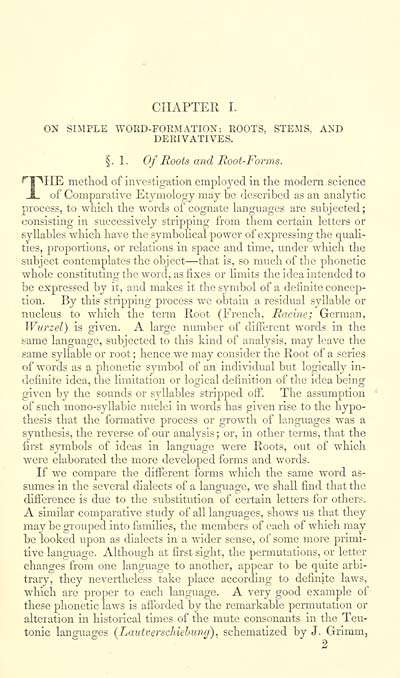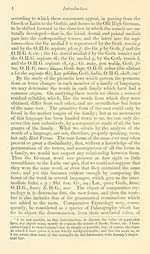Blair Collection > Celtic studies
(33)
Download files
Complete book:
Individual page:
Thumbnail gallery: Grid view | List view

CHAPTER I.
ON SIMPLE TVORD-FOEMATION: ROOTS, STEMS, AND
DERIVATIVES.
§.1. Of Roots and Root- Forms.
THE method of investigation employed in tlie modern science
of Comparative Etymology may be described as an analytic
process, to which the words of cognate languages are subjected;
consisting in successively stripping from them certain letters or
syllables which have the symbolical power of expressing the quali-
ties, proportions, or relations in space and time, under which the
subject contemplates the object — that is, so much of the phonetic
whole constituting the word, as fixes or limits the idea intended to
be expressed by it, and makes it the symbol of a definite concep-
tion. By this stripping process Ave obtain a residual syllable or
nucleus to which the term Root (French, Racine; German,
Wurzel) is given. A large number of different words in the
same language, subjected to this kind of analysis, may leave the
same syllable or root ; hence we may consider the Root of a series
of words as a phonetic symbol of an indiAadual but logically in-
definite idea, the limitation or logical definition of the idea being
given by the sounds or syllables stripped off. The assumption
of such mono-syllabic nuclei in words has given rise to the hypo-
thesis that the formative process or growth of languages was a
synthesis, the reverse of our analysis ; or, in other terms, that the
first symbols of ideas in language were Roots, out of which
were elaborated the more developed forms and words.
If we compare the different forms which the same word as-
sumes in the several dialects of a language, we shall find that the
diflerence is due to the substitution of certain letters for others.
A similar comparative study of all languages, shows us that they
may be grouped into families, the members of each of which may
be looked upon as dialects in a A\ader sense, of some more primi-
tive language. Although at first sight, the permutations, or letter
changes from one language to another, appear to be quite arbi-
trary, they nevertheless take place according to definite laws,
wdiich are proper to each language. A very good example of
these phonetic laws is afforded by the remarkable permutation or
alteration in historical times of the mute consonants in the Teu-
tonic lanfruas'es (Lautverschiehung), schematized by J. Grimm,
^ ^ 2
ON SIMPLE TVORD-FOEMATION: ROOTS, STEMS, AND
DERIVATIVES.
§.1. Of Roots and Root- Forms.
THE method of investigation employed in tlie modern science
of Comparative Etymology may be described as an analytic
process, to which the words of cognate languages are subjected;
consisting in successively stripping from them certain letters or
syllables which have the symbolical power of expressing the quali-
ties, proportions, or relations in space and time, under which the
subject contemplates the object — that is, so much of the phonetic
whole constituting the word, as fixes or limits the idea intended to
be expressed by it, and makes it the symbol of a definite concep-
tion. By this stripping process Ave obtain a residual syllable or
nucleus to which the term Root (French, Racine; German,
Wurzel) is given. A large number of different words in the
same language, subjected to this kind of analysis, may leave the
same syllable or root ; hence we may consider the Root of a series
of words as a phonetic symbol of an indiAadual but logically in-
definite idea, the limitation or logical definition of the idea being
given by the sounds or syllables stripped off. The assumption
of such mono-syllabic nuclei in words has given rise to the hypo-
thesis that the formative process or growth of languages was a
synthesis, the reverse of our analysis ; or, in other terms, that the
first symbols of ideas in language were Roots, out of which
were elaborated the more developed forms and words.
If we compare the different forms which the same word as-
sumes in the several dialects of a language, we shall find that the
diflerence is due to the substitution of certain letters for others.
A similar comparative study of all languages, shows us that they
may be grouped into families, the members of each of which may
be looked upon as dialects in a A\ader sense, of some more primi-
tive language. Although at first sight, the permutations, or letter
changes from one language to another, appear to be quite arbi-
trary, they nevertheless take place according to definite laws,
wdiich are proper to each language. A very good example of
these phonetic laws is afforded by the remarkable permutation or
alteration in historical times of the mute consonants in the Teu-
tonic lanfruas'es (Lautverschiehung), schematized by J. Grimm,
^ ^ 2
Set display mode to: Large image | Transcription
Images and transcriptions on this page, including medium image downloads, may be used under the Creative Commons Attribution 4.0 International Licence unless otherwise stated. ![]()
| Early Gaelic Book Collections > Blair Collection > Celtic studies > (33) |
|---|
| Permanent URL | https://digital.nls.uk/75771545 |
|---|
| Description | A selection of books from a collection of more than 500 titles, mostly on religious and literary topics. Also includes some material dealing with other Celtic languages and societies. Collection created towards the end of the 19th century by Lady Evelyn Stewart Murray. |
|---|
| Description | Selected items from five 'Special and Named Printed Collections'. Includes books in Gaelic and other Celtic languages, works about the Gaels, their languages, literature, culture and history. |
|---|

